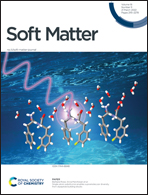Nanocomposite tectons as unifying systems for nanoparticle assembly†
Abstract
Nanocomposite tectons (NCTs) are nanocomposite building blocks consisting of nanoparticle cores functionalized with a polymer brush, where each polymer chain terminates in a supramolecular recognition group capable of driving particle assembly. Like other ligand-driven nanoparticle assembly schemes (for example those using DNA-hybridization or solvent evaporation), NCTs are able to make colloidal crystal structures with precise particle organization in three dimensions. However, despite the similarity of NCT assembly to other methods of engineering ordered particle arrays, the crystallographic symmetries of assembled NCTs are significantly different. In this study, we provide a detailed characterization of the dynamics of hybridizations through universal (independent of microscopic details) parameters. We perform rigorous free energy calculations and identify the persistence length of the ligand as the critical parameter accounting for the differences in the phase diagrams of NCTs and other assembly methods driven by hydrogen bond hybridizations. We also report new experiments to provide direct verification for the predictions. We conclude by discussing the role of non-equilibrium effects and illustrating how NCTs provide a unification of the two most successful strategies for nanoparticle assembly: solvent evaporation and DNA programmable assembly.



 Please wait while we load your content...
Please wait while we load your content...